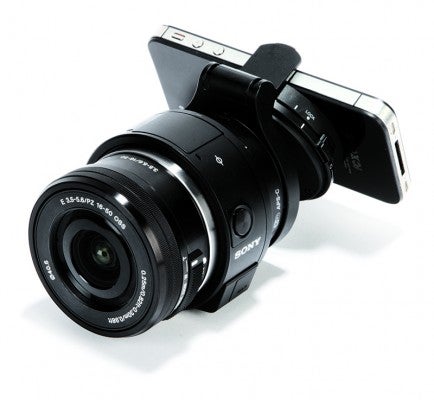Sony’s 2G lens-style cameras have arrived, including the curiously quirky QX1, which features the ability to use E-mount lenses. Richard Sibley tries it out for our Sony QX1 field test
Sony QX1 at a glance:
- 20.1-million-pixel, APS-C CMOS sensor
- Takes Sony E-mount lenses
- Bionz X processor
- Records both JPEG and raw
- ISO 100-16,000
- Uses Sony PlayMemories Mobile app, for iOS, Android and Windows devices
- Price £249 (body only)
 Image: Sony’s unconventional QX1 connects to tablets and smartphones by Wi-Fi and accepts E-mount lenses
Image: Sony’s unconventional QX1 connects to tablets and smartphones by Wi-Fi and accepts E-mount lenses
Sony’s QX range was one of the most-talked about camera announcements of 2013. Sony devised the term ‘lens-style camera’ to describe the new devices, based on the fact that they were primarily a lens and image sensor combined.
With no screen, the QX cameras need to be connected via Wi-Fi to a tablet or smartphone, on which the Sony PlayMemories Mobile app can be used to compose images, change settings and playback images and videos that have been captured.
Images are saved to a micro-SD card inside the QX camera, but either full resolution or 2-million-pixel resolution images can also be sent to the smart device, allowing them then to be edited or shared on social media or via email.
The cameras are primarily designed for those that enjoy the interface offered by a smartphone camera, but aren’t satisfied with the built-in camera, perhaps because of low- light performance or lack of zoom.
The first pair of cameras, the QX10 and QX100 had 10x and 3x optical zoom lenses respectively. However, whereas the QX10 had a 20-million-pixel compact camera-size sensor, the QX100 used a larger 20-million-pixel 1in sensor, the same as used in the RX100 enthusiast compact camera. This more premium version offered the image quality of the RX100, but was around £150 cheaper at the time of release.
Now Sony has taken the concept a step further with the QX1, which is essentially a 20.1-million-pixel APS-C size sensor with a Sony E-mount. Imagine taking the Alpha 5000 compact-system camera and removing the rear screen, the majority of the buttons and the grip; that is the QX1.
It seems such a bizarre approach to designing a camera system and integrating it with smartphone technology that I couldn’t help but get excited by the novelty of it all.
Connection
With such limited features on the QX1, the camera itself is straightforward to set up. It takes micro-SD cards and the same NP-FW50 battery that is used in all of Sony’s compact system cameras. This is charged via a micro USB connection, which is useful as it’s the same one used to charge many mobile phones and tablets (though not Apple devices).
The only other features on the QX1 are: a tiny LCD panel showing the battery life, Wi-Fi connection and whether a card is inserted; the power and shutter buttons; and a tiny pop-up flash with a guide number of 4m.
To connect to a smartphone you need to turn on the QX1, select its Wi-Fi connection on the phone, input the password (printed inside the battery door) and then open the Sony PlayMemories Mobile app. The password isn’t required on subsequent connections. If your phone has NFC, you can bypass this process simply by touching the two devices together. This will even open up the PlayMemories mobile app, or if you don’t have it, take you to its download page on the Google Play store.
Manual connection takes less than a minute, and NFC just seconds. Once the devices are paired, you can start shooting.
 Image: The QX1’s 20-million-pixel sensor records an impressive amount of detail
Image: The QX1’s 20-million-pixel sensor records an impressive amount of detail
In Use
The handling of the QX camera is unique, largely due to the fact that the camera and smartphone don’t need to be physically connected in any way. The camera comes with a sprung mount to attach it to a smartphone, but this doesn’t have to be used. So you can hold a smartphone in one hand, acting as a live-view screen, and the camera in the other, moving it around at all sorts of angles. While you can do this with other cameras with a Wi-Fi connection, the shape of the QX1 positively encourages it.
There is a slight delay in the Wi-Fi between the devices, resulting in a small lag in the display. Touching the screen focuses the lens on the corresponding part of the image. Again there is a lag, and focusing with the 16-50mm power zoom lens isn’t the fastest. But overall the touch-focus facility works well, and again feels like the natural thing to do when using a smartphone.
The fastest method of shooting is to use the shutter button on the QX1 itself. As long as the lens is focused, this takes a shot as quickly as any other camera. By default, a preview image is then sent to the mobile device and displayed on screen for a few seconds. This can get a little annoying if you wish to take another shot, so I disabled the preview setting in the app.
Image Control and Quality
 Image: With its APS-C sensor, the QX1 allows creative control over depth of field.
Image: With its APS-C sensor, the QX1 allows creative control over depth of field.
With the same Bionz processing engine and 20.1-million-pixel APS-C size sensor as the Alpha 5000, the image quality is virtually identical. You can shoot raw and JPEG images, with the raw images saved on the memory card and a JPEG preview sent to the phone. This elevates the QX1 above being just a gimmick, by offering excellent image quality.
Changing the camera’s shooting settings must be done via the Sony PlayMemories Mobile app. Shooting modes include Auto, Intelligent Auto, Program and Aperture priority. Depending on the mode, it is possible to change the aperture, exposure compensation, white balance and ISO sensitivity. You can also switch to manual focusing and continuous shooting.
The range of options in the menu isn’t as comprehensive as you would see on a compact system camera, but it’s enough to feel as if you are involved in creating the image. However, changing settings can be a little fiddly if you have a smartphone with a smaller screen.
Lenses
Of course, the highlight feature of the QX1 is its ability to use E-mount lenses. It was fun being able to switch between different optics, knowing that the image quality would match that of a compact system camera.
If you wish to use the QX1 and a lens larger than the 16-50mm power zoom, though, you need a lot of faith in the sprung clip that attaches it to a phone. This is much stronger than it looks, but you’ll find that you hold the lens more than the smartphone.





